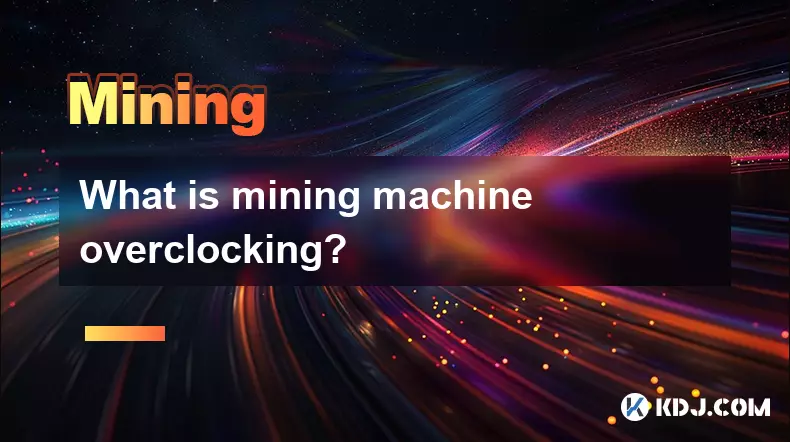-
 bitcoin
bitcoin $109523.663807 USD
-0.13% -
 ethereum
ethereum $4019.526508 USD
2.06% -
 tether
tether $1.000482 USD
0.00% -
 xrp
xrp $2.776815 USD
0.18% -
 bnb
bnb $958.942396 USD
0.12% -
 solana
solana $204.294698 USD
3.84% -
 usd-coin
usd-coin $0.999693 USD
0.00% -
 dogecoin
dogecoin $0.232115 USD
2.09% -
 tron
tron $0.338028 USD
0.84% -
 cardano
cardano $0.790920 USD
1.50% -
 hyperliquid
hyperliquid $44.871443 USD
5.60% -
 ethena-usde
ethena-usde $1.000322 USD
0.04% -
 chainlink
chainlink $21.034165 USD
2.60% -
 avalanche
avalanche $28.794831 USD
-0.54% -
 stellar
stellar $0.360466 USD
1.24%
What are the cooling solutions for mining rigs?
Efficient cooling like immersion or hybrid systems enhances mining rig performance, reduces noise, and extends hardware lifespan while enabling high-density deployments.
Sep 21, 2025 at 09:01 pm

Cooling Solutions for Mining Rigs
1. Air cooling remains one of the most widely adopted methods in cryptocurrency mining operations. Fans and heatsinks are installed directly on GPUs and ASICs to dissipate heat generated during continuous computational tasks. Proper airflow design within mining racks ensures hot air is expelled efficiently, preventing thermal throttling. Dust filters are often added to maintain clean components and improve long-term performance.
2. Immersion cooling involves submerging entire mining rigs in a non-conductive liquid that absorbs heat effectively. The dielectric fluid transfers thermal energy away from components without risking electrical shorts. This method drastically reduces ambient temperature around equipment and allows for higher density deployments in limited spaces. Maintenance is simplified since there’s no need for traditional fans or dust management.
3. Liquid cooling loops use water blocks attached to critical components like GPUs and processors. Coolant circulates through these blocks, absorbing heat before passing through radiators where it is released into the environment. While more complex to install than air-based systems, they offer superior thermal regulation and quieter operation. Custom loop designs allow scalability depending on rig size and power draw.
4. Environmental control includes managing the space where mining rigs operate. Enclosures with dedicated HVAC systems maintain stable temperatures regardless of external weather conditions. Dehumidifiers prevent moisture buildup that could damage electronics. Strategic placement of intake and exhaust vents enhances passive cooling and reduces reliance on mechanical systems.
5. Hybrid setups combine multiple cooling techniques to optimize efficiency. For instance, air-cooled racks may be placed inside climate-controlled rooms, while select high-power ASICs utilize direct-to-chip liquid cooling. These combinations balance cost, complexity, and performance, making them ideal for mid-to-large-scale mining farms aiming for sustainable heat management.
Benefits of Efficient Cooling Systems
1. Stable operating temperatures extend the lifespan of mining hardware. Components subjected to prolonged overheating suffer from degraded solder joints and reduced transistor reliability. Consistent cooling prevents premature failure and minimizes downtime across large fleets of machines.
2. Optimal thermal conditions enhance hash rate consistency and reduce energy waste due to thermal throttling. When miners run at peak efficiency, each watt consumed contributes directly to computational output rather than being lost as excess heat.
3. Noise reduction is a significant advantage, especially in residential or shared facilities. Traditional fan-heavy setups generate high decibel levels, whereas immersion and liquid cooling operate almost silently. This makes certain cooling methods more suitable for urban environments or co-location centers.
4. Space utilization improves with advanced cooling solutions. High-density configurations become feasible when heat is managed effectively, allowing operators to maximize output per square foot. This is particularly valuable in regions where real estate costs are high.
5. Lower ambient heat output reduces strain on building infrastructure. Data centers equipped with efficient cooling avoid overloading electrical circuits and ventilation systems, contributing to overall operational safety and compliance with fire codes.
Challenges in Implementing Cooling Technologies
1. Initial investment varies significantly between cooling types. Air cooling requires minimal upfront cost but may not suffice for high-output rigs. Immersion tanks and custom liquid loops demand substantial capital, including specialized containers, fluids, and monitoring tools.
2. Technical expertise is necessary for installation and maintenance. Improper sealing in liquid systems can lead to leaks, damaging expensive hardware. Operators must understand fluid dynamics, pump reliability, and corrosion resistance when selecting materials.
3. Compatibility issues arise when integrating new cooling methods with existing mining hardware. Not all ASIC models support direct-to-die cooling modifications. Retrofitting older units may require custom mounting brackets or thermal interface replacements.
4. Fluid availability and disposal present logistical concerns. Dielectric coolants used in immersion setups are proprietary and sometimes difficult to source. Environmental regulations govern the handling of spent liquids, requiring proper recycling procedures.
5. Monitoring and automation play a crucial role in sustaining cooling effectiveness. Sensors track temperature gradients across components, triggering alerts if thresholds are exceeded. Integration with mining management software enables dynamic adjustments based on workload and environmental changes.
Frequently Asked Questions
What type of coolant is commonly used in immersion cooling for mining rigs?Miners typically use synthetic dielectric fluids such as 3M Novec or Shell Diala oil. These liquids do not conduct electricity and have excellent thermal transfer properties, making them safe for full submersion of electronic components.
Can standard PC fans be used effectively for large-scale mining farms?While standard fans can work for small setups, industrial-grade axial or centrifugal blowers are preferred in large farms. They provide higher static pressure and airflow volume needed to manage dense rack configurations and elevated ambient temperatures.
Is it possible to mix air and liquid cooling in the same mining facility?Yes, many facilities adopt hybrid approaches. Air cooling handles general ambient control while liquid cooling targets specific high-heat devices like top-tier GPUs or next-generation ASICs, ensuring balanced thermal distribution.
How does dust accumulation affect cooling efficiency in mining rigs?Dust acts as an insulator on heatsinks and fan blades, reducing their ability to transfer heat. Over time, this leads to increased operating temperatures and potential hardware failure. Regular cleaning schedules and filtered intakes mitigate these risks.
Disclaimer:info@kdj.com
The information provided is not trading advice. kdj.com does not assume any responsibility for any investments made based on the information provided in this article. Cryptocurrencies are highly volatile and it is highly recommended that you invest with caution after thorough research!
If you believe that the content used on this website infringes your copyright, please contact us immediately (info@kdj.com) and we will delete it promptly.
- Sleep Token's Macabre Metal: A Ritualistic Rise to Rock Stardom
- 2025-09-27 22:25:15
- BlockchainFX: Is This Presale the Next Binance?
- 2025-09-27 22:25:15
- ORDER Token's Binance Listing Ignites Crypto Rally: What Traders Need to Know
- 2025-09-27 22:30:01
- Ethereum ETFs Feel the Heat: Investors Exit as Staking Approval Looms?
- 2025-09-27 22:30:01
- Crypto Presales & Meme Coins: Hunting for the Next 100x Opportunity
- 2025-09-27 22:30:01
- Cardano (ADA) Price Prediction: Bullish Scenarios and Market Dynamics
- 2025-09-27 22:30:16
Related knowledge

The difference between staking and mining
Sep 24,2025 at 05:18am
Understanding Staking in the Cryptocurrency Ecosystem1. Staking involves holding funds in a cryptocurrency wallet to support the operations of a block...

How to participate in testnet mining?
Sep 22,2025 at 09:18am
Understanding Testnet Mining in the Crypto Ecosystem1. Testnet mining is a method used by blockchain developers to simulate real-world conditions on a...

How to dispose of abandoned mining machines?
Sep 19,2025 at 08:19pm
Assessing the Condition of Abandoned Mining Rigs1. Begin by inspecting each mining machine for visible damage, corrosion, or missing components. Machi...

How to identify high-quality mining pools?
Sep 21,2025 at 03:19pm
Reputation and Track Record1. A mining pool’s reputation is built over time through consistent performance and transparency. Pools that have operated ...

Advantages of decentralized mining pools
Sep 20,2025 at 04:36pm
Enhanced Security and Resistance to Censorship1. Decentralized mining pools operate on blockchain-based smart contracts, eliminating the need for a ce...

What is mining machine overclocking?
Sep 21,2025 at 07:19pm
Understanding Mining Machine Overclocking1. Mining machine overclocking refers to the process of increasing the operating frequency of a cryptocurrenc...

The difference between staking and mining
Sep 24,2025 at 05:18am
Understanding Staking in the Cryptocurrency Ecosystem1. Staking involves holding funds in a cryptocurrency wallet to support the operations of a block...

How to participate in testnet mining?
Sep 22,2025 at 09:18am
Understanding Testnet Mining in the Crypto Ecosystem1. Testnet mining is a method used by blockchain developers to simulate real-world conditions on a...

How to dispose of abandoned mining machines?
Sep 19,2025 at 08:19pm
Assessing the Condition of Abandoned Mining Rigs1. Begin by inspecting each mining machine for visible damage, corrosion, or missing components. Machi...

How to identify high-quality mining pools?
Sep 21,2025 at 03:19pm
Reputation and Track Record1. A mining pool’s reputation is built over time through consistent performance and transparency. Pools that have operated ...

Advantages of decentralized mining pools
Sep 20,2025 at 04:36pm
Enhanced Security and Resistance to Censorship1. Decentralized mining pools operate on blockchain-based smart contracts, eliminating the need for a ce...

What is mining machine overclocking?
Sep 21,2025 at 07:19pm
Understanding Mining Machine Overclocking1. Mining machine overclocking refers to the process of increasing the operating frequency of a cryptocurrenc...
See all articles









































































